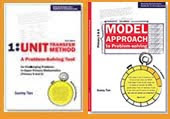From: Madam Ser, Parent
Dear Sir
We refer to the UNIT TRANSFER METHOD Primary 4 book, Chap 2, Q8
Mrs Gan is changing the water in her fish tank.
If she uses a 4-litre pail to fill the tank, 4 litres of water will overflow.
If she uses a 2-litre pail to fill the tank, she will need another 3 more pails of water.
How many litres of water are needed to fill the fish tank.
The answer provided by the book indicates that the fish tank’s capacity is “16 litres”
However, when we work backwards :
Case 1: If fish tank’s capacity is 16 litres, that means that Mrs Gan used 4 pails of 4 litres each to fill the tank. The amount of water available to Mrs Gan was 20 litres, so, 4 litres would overflow.
Case 2: If fish tank’s capacity is 16 litres, that means that Mrs Gan used 8 pails of 2 litres each to fill the tank. If the amount of water available to Mrs Gan was 20 litres, so, there would still be an excess of 4 litres
Please clarify.
From desk of Sunny Tan……..
Case 1: If fish tank’s capacity is 16 litres, that means that Mrs Gan used 4 pails of
4 litres each to fill the tank. The amount of water available to Mrs Gan was 20 litres, so, 4 litres would overflow.
Comment: Therefore the number of pails used is 5 pails.
Case 2: If fish tank’s capacity is 16 litres, that means that Mrs Gan used 8 pails of 2 litres each to fill the tank. If the amount of water available to Mrs Gan was 20 litres, so, there would still be an excess of 4 litres
Comment 1: If she use 8 pails of 2-litre each, she will fill up the tank completely, she
will not need another 3 pails, this assumption is invalid as it contradicts the question.
Comment 2: If the amount of water available to Mrs Gan was 20 litres, so, there
would still be an excess of 4 litres
This assumption is invalid. Case 1 and Case 2 scenarios are if..and if…, the two events never took place. Therefore we cannot assume that 20 litres of water, that is available in Case 1 is equal to that in Case 2.
Comment 3: Number of pails = 5 pails.
Total volume = 5x2 =10 litres
The capacity is 16 litres
Therefore she need extra 6 litres, which is 3 additional pails.
-----------------------------------------------------------------------------------------------------------------
From: Madam Ser, Parent
Dear Sir
Thank you for your explanation.
The model that we created as below:
U : No. of 4-litre pails
P : No. of 2-litre pails
Capacity of tank = 4U
4 litres that overflowed = 1 pail = 1U
Therefore, 4U = 16 litres
Check :
2P + 6 litres = 4U = 16 litres
Therefore, P = 5 pails of 2-litre each, resulting in shortage of 6 litres (3 pails of 2-litre each)
Please advise if the above interpretation is correct. Else, please help provide working.
Thank you.
From desk of Sunny Tan……..
I noticed from your model, the U and P is the same.
In fact, this fact can be established in the beginning, that is the number of pails used in both scenarios Case 1 and Case 2 are the same.
Thus, it is unnecessary to introduce P, too many unknown variables may confuse the child.
Let define: 1u = represents the number of pails
2 u = 10
1u = 5 (5 pails)
Either use
case 1: 4u – 4 = 4x5 – 4 =16
case 2: 2u + 6 = 2x5 + 6 =16
Hope this helps.






















